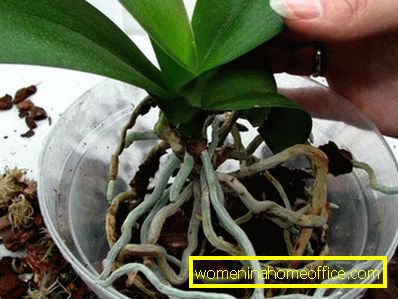Orchid
Orchid - is an exotic plant, which is usually bred in room conditions. Its delicate and exquisite flowers are able to decorate any interior and deliver a truly aesthetic pleasure from contemplation. Green lovers often decorate the living space with this royal perennial.
Taking care of a plant is not so difficult as it may seem at first glance. But there are some nuances that the orchid demands strongly. Leaving after flowering, for example, is especially important for it: the development and state of greenery depends on it in the future. The rest of the care of the pet is reduced to the observance of heat and light mode, watering and pruning.

The state of rest occurs in many plants. Its manifestations (or absence), as well as the nature of the flow, are largely predetermined by the climatic conditions of the homeland of a particular plant. For most orchids, this period is necessarily present in the life cycle. Their relative peace comes after the shoots finish their growth. Temporary hibernation is the best condition for the formation of ovaries and subsequent flowering of plants. But this happens only if the conditions of care are fully respected. Otherwise, the pet may fall into a state of forced rest, in order to survive difficult conditions, and it will no longer bloom.
If the plant is properly contained, focusing on its characteristics and needs, then from the buds that have appeared on it, a color will surely form, and after this, a phase of deep rest will begin in the life of the orchid.
During this period, all major processes are slowed down just as much as the sleeping orchid requires. Care after flowering at home is simple, but depending on the type of "look after" the plants in different ways. In total, there are four types of fading.
Period of conditional rest
This phase occurs in many orchids, but most often occurs in Cattleus, and 2 times in one season - after the formation of the pseudobulb and blooming. At this time are required:
- reduced soil moisture
- a decrease in temperature or a pronounced difference in thermometer marks day and night,
- cancel feeding.
Compliance with this regime will help the orchid to form an ovary and prepare it for the upcoming flowering.
Pronounced rest phase

This life cycle is characteristic of dendrobium and cymbidiums, which are needed at this time interval:
- maximum reduction in watering
- some air cooling in the habitat,
On the sleeping green will appear ovary, which later turns into color. Any deviations from the regime lead to rebirth of the kidneys and the appearance of Kake (these are airborne children), and the long-awaited dissolution does not occur at all.
Dry rest mode
This period is rare, but it requires a radical transformation of the regime. The main difference of this resting phase from others is the complete cessation of watering for a long time - up to three months. The air temperature in this case is traditionally lowered, but it happens that this is not required. It all depends on the native habitat of the orchid, and more precisely, on its climate. Dry hibernation is usually characteristic of the King's dendrobium.
No rest period
Some members of the orchid group do not require close attention to themselves. They grow, develop and bloom evenly throughout the year.
Such plants include pafiopedilyum. This orchid, care after flowering which is not needed at all. It is recommended to beginner gardeners to begin their acquaintance with this group of plants, because other species may be difficult for an amateur.
Many lovers of indoor plants are interested in phalaenopsis orchid. Care at home after flowering for this plant does not differ from the usual, and this is its feature. This flower does not have a pronounced period of rest, and it is easy to contain it. Phalaenopsis loves light, but does not tolerate direct sunlight. The air temperature for it should be the same in winter and in summer - 22-25 degrees. Water the flower twice a week (in summer), using distilled water at room temperature. In winter, it is enough to moisten the substrate once in seven days.
They are suitable for beginners and cymbidium, combinated fossil, one glogum large: they have a short period of rest, which falls in the winter.
Getting out of winter sleep

As a rule, from hibernation, the plants come out independently. But if suddenly this did not happen, then you can help the green. How to revive the orchid?
- For a while, lower the air temperature.
- Reduce the frequency of watering;
- Create a noticeable difference between day and night temperatures.
- Moisten the roots with warm (36-38 ° C) water, and then pour it into the pan.
- Feed.
- Replant to another soil.
The beauty of orchids is simply amazing, especially since each member of this group has its own exquisite color. Some of them are tolerant to various climatic conditions and are capable of blooming year-round. A variety of types and forms of orchids allows you to choose a "green friend", the most suitable for your home.